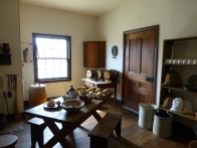The most fascinating thing about the Battle of Mine Creek is how little your average Kansan knows about it. It was one of the most important cavalry battles of the Civil War. It marked the end of the South’s last major campaign west of the Mississippi River.
Ask Kansans to rattle off important Kansas people or Kansas events connected to the Civil War, the list will probably be limited to William Quantrill, John Brown, the Lawrence Massacre, James Lane, and Bloody Bill Anderson.
Yet if you ask them about the day that brought nearly 10,000 men to a Kansas field and left more than 600 of them dead or wounded, they’ll probably look at you in bewilderment.
Welcome to the Battle of Mine Creek.
Here is a simplified version of events:
By late 1864, the War Between the States was shifting in favor of the Union. Fearful that the reelection of President Abraham Lincoln would lead to the South’s defeat, they CSA decided that if they could recapture a Union state and seat a Confederate governor, they might be able to change the outcome of the election and the war.
When most people think of border war states, they think of Kansas. But by the time the Civil War was underway, Kansas had pretty much settled on being a Union anti-slavery state, even if all of it’s residents didn’t agree. Missouri, on the other hand, was much more on the fence. Many of the pro-slavery people who fled from the sometimes-dangerously enthusiastic Kansas abolitionists ended up in Missouri, and though Missouri technically fought for the Union, many of its citizens owned slaves and sympathized with the Southern cause.
Enter Maj. Gen. Sterling Price.
In an effort to gain control of Missouri, Price was given this to-do list:
- Conquer St. Louis, the most abolitionist of Missouri cities.
- If that’s not possible, take over Jefferson City, and while there, seat a new governor.
- If that’s not possible, smack down the areas around Kansas City.
- If all that fails, destroy as much of Kansas as possible on the return trip.
While he was on his march across Missouri, he was to accumulate additional men and commandeer supplies. So began what was to be known as Price’s Raid.
By the middle of October, things were not going too well for Price’s men. St. Louis was too heavily fortified, as was Jefferson City. So they continued marching west, successfully adding men to the ranks and filling wagons with supplies, weapons, and ammunition. When the reached what now the Kansas City metro area, they were forced into retreat at what would be called the Gettysburg of the West: the Battle of Westport.
Missouri was lost, but Price and his men still had one item on the list they could accomplish: do damage to Kansas.
The Kansans, though, were ready. In October, the governor called the Kansas militia into service, and Gen. Samuel Curtis declared the state was under martial law. The Union was in hot pursuit of Price.
Meanwhile, Price and his men was storming through Kansas along the road to Fort Scott. That’s when the weather and geography sealed their fate. Heavy rains had filled the Marais des Cygnes River and Mine Creek. The ground was soft and muddy and both waterways were hard to cross. The men on foot could have managed, but the problem was the wagons and horses. By that time, Price’s men had amassed a fortune in ammunition, weapons, and other supplies, enough to form an entire wagon train–a slow-moving, frequently-stuck-in-the-mud wagon train. Price and many of his men rode ahead, but the wagons and the men guarding them found themselves in the bottom of a ravine trying to cross a swollen creek at a small rocky ford when the Union men caught up with them.

A view from the rocky ford in Mine Creek. Slowed down by heavy wagons sinking in the mud, Price’s men were trapped when the Union cavalry arrived.
In a field that rarely saw humans moving through it, about 10,000 men clashed with cannons, swords, rifles, and guns on October 25, 1864. The Confederates outnumbered the Union men nearly three to one, but the Northerners had higher ground and better weapons on their side, and by the time it was over, nearly 1,200 of Price’s men would be wounded, captured, or killed. The women from the nearby farm houses were tasked with caring for the injured and dying men. The dead were piled into a ravine and buried, and the smell of death lingered long after the battle was over.

Looking south at the Mine Creek Battlefield site. The land has been returned to native prairie, recreating how it would have appeared to men who fought there in 1864.
It was an amazing defeat. Soon after, those very wagons were set ablaze so that they couldn’t be confiscated by the Union or further hold back the retreating men.
What amazes me about the Battle of Mine Creek is the fact that all we know about it is what was recounted in the letters and journals of the men who were there. The battle didn’t even have a proper name, because it didn’t happen in a town; it happened in a field with only a few farmhouses in the area. There were no reporters or photographers nearby. Yet it ended Price’s efforts to destroy Kansas.
Fortunately for us, the battlefield isn’t in an area where it was paved over and planted with houses before anyone realized they’d destroyed a piece of history. The Mine Creek Battlefield State Historic Site has preserved the land (even though their original land acquisition turned out to be west of the actual battlefield). The land has been returned to native prairie, making it look and feel much more like it would have 150 years ago. Mowed paths walk you through the battlefield, and kiosks highlight important elements of the battle. You can see for yourself where Price’s men found themselves trapped trying to cross the rocky ford on Mine Creek.

Get oriented at the historic site’s museum, where you can watch a video detailing the history of the battle, see evidence of the battle recovered by archeologists, and study maps of the battlefield.
But before you tackle the battlefield, I recommend visiting the museum itself. The 45-minute video, which originally aired on the History Channel, will orient you to the finer points of the battle (much of which I glossed over here). Artifacts collected by archeologists are thoughtfully interpreted and displayed. One of our favorite objects was a binder explaining the archeological process that helped determine the actual location of the Fort Scott road and the battlefield. Give yourself at least 90 minutes at the museum to really take in the information and ask questions.

One display shows the various types of ammunition found by archeologists on the site of the Battle of Mine Creek.
Then hit the trails, which are easy enough to follow (it’s pretty easy to see a trail when the grass is six feet tall on either side of a mowed path). Amazingly, we only confused ourselves when we tried to follow the trail map, which did not accurately represent the trails. If you go before a hard freeze, douse yourself in bug spray.

Well-maintained trails through the grasses and woody area by the creek are dotted with kiosks that tell the story of the Battle of Mine Creek. Bug spray is a good idea if you visit during the spring, summer, or fall before a hard freeze.
The battlefield land is quiet, save for the sound of insects and the wind blowing through the grasses and trees. It is easy to forget the present day, and as you look north up the hill from the creek, you can lose yourself in the moment and imagine what it must have been like for those Confederate soldiers, who were trapped by their wagons, as they watched the Union soldiers ride over the hill.
***
The battlefield trails and interpretive kiosks are open all year long from dawn to dusk. However, the museum is only open from April through October. If you’re traveling far to visit, consider spend the entire day in the area and visit the Marais des Cygnes Massacre Site and the town and cemetery of Trading Post for a more complete understanding of how the area was repeatedly assaulted in the times leading up to and including the Civil War.





















































